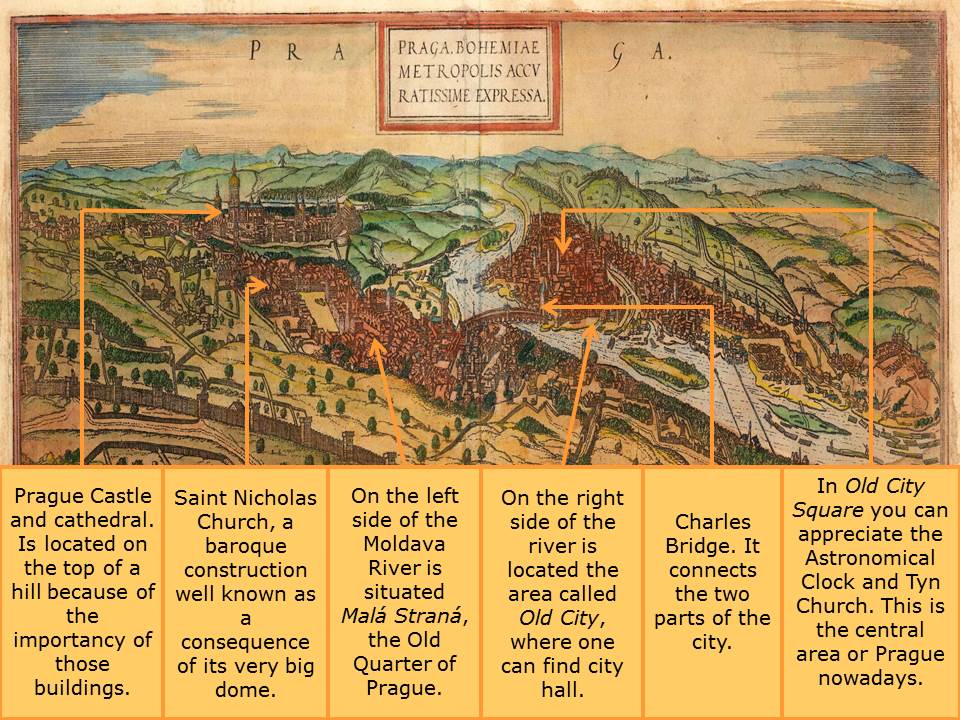In the picture, a copper engraving and later handcolored made by Georg Braun and Franz Hogenberg between 1572 and 1578, we could see the city of Prague in the late XVI century. Prague is the capital of Czech Republic and also of Bohemia, and it is situated in central Europe. The city is located in a meander of the Moldava River near the point it reaches the Elba River. In the right bottom part of the image is observable the transporting of logs by water. As the Moldava River is navigable, it was an important trade spot between the Slavic world and Western Europe, and served as a crossroad for several trade routes.
Concerning its urban structure, the engraving shows three main areas. On the top of the hill is situated the Prague Castle and the cathedral. This positioning is reminiscent of ancient Greek cities, in which you could observe the separation between the areas of worship and the ones where the inhabitants live. Under the castle, the others two areas have an irregular layout from the Middle Ages. The one on the left is the old quarter, also called Malá Strana. One can appreciate easily the clustered distribution of the houses surrounding a big square. The part on the right is called Old City or Stare Mesto. We could also see the city walls around. Related to the style of buildings, the majority of them are Gothic.
Connecting the two parts of the city we can observe Charles Bridge, made of big stones and built between the XIV and XV centuries. The measures are a bit more than 500 meters length and 10 width. It is named after his creator, Emperor Charles IV, who put the first stone in 1357 to replace Judith Bridge, another one destroyed by floods.
Inside Malá Strana we could appreciate some architectural ensembles. The biggest and most important one is the Prague Castle, which stand out in the background of the picture, in a strategic position from which you can see the whole city. Inside the castle is located Saint Vito’s Cathedral, a Gothic temple that started being built in the XIV century. It is obvious that the religion and the real family were very important in that period of time because of the location of those buildings. Another beautiful site is Saint Nicholas Church, a Baroque construction well known as a consequence of its very big dome easily observable from the top of the city.
On the right side of the river, the Old City, is located the main square of Prague called Old City Square. This area is the focal point of Prague nowadays. In that place one can notice the marvelous Astronomical Clock, a part of the city hall. It was made in XV century. In that square is situated another important Gothic building, Tyn Church. Another remarkable place to take into account is the Powder Tower, built in 1475. It is a blackened tower that was one of the old entrances to the city. It is important to mention that at the top part of that area is located the Jewish Quarter, where there are six synagogues distributed over that district.
We should mention that the biggest expansion of the city took place between XII and XIII centuries because of the political and economic prosperity, so that is the reason why most of the monuments and buildings are Gothic. Then, during the XIV century under Charles IV, Prague enjoyed its heyday. The king erected the Bishop’s Palace in 1344 and constructed the university four years later. It was one of the most important cities in Europe, and a consequence of it was that the great European artists moved there, especially Italians. The decline of the city started with the Counter Reformation and with the Thirty Years War (1618-1648). However, it recovered a little in the XVII century, when the Baroque style flourished.
To conclude, we want to highlight that instead of the World War 2 or the URSS’s debris, nowadays Prague is one of the most visited cities all over the world because of his importance both historically and artistically. We are sure it will continue because the only way to realize the beauty and the magnificence of that place is seeing it in person.
Álvaro Rodríguez López

